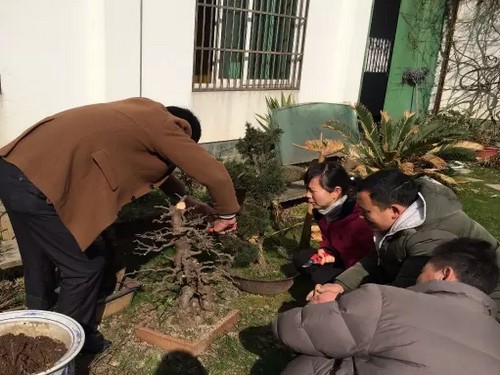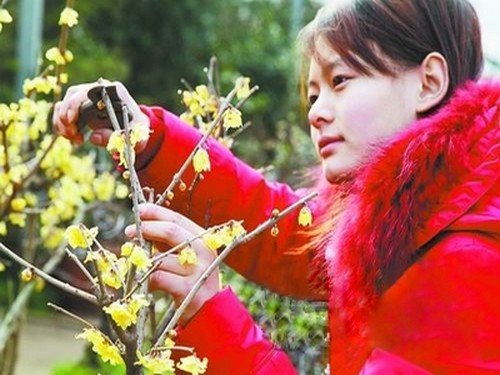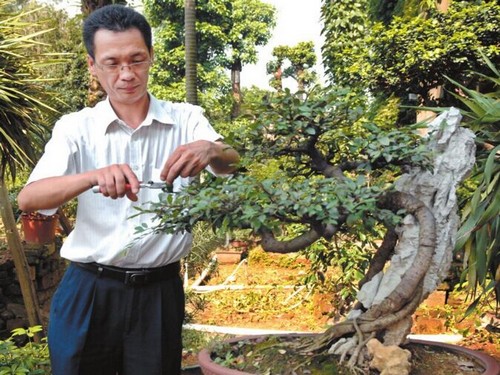Bonsai pruning technique
Bonsai pruning is synonymous with the means of making potted trees, although there are still techniques such as flat binding, pulling and hanging, traction, carving, grafting and so on, but it is often agreed to be attributed to "pruning". As the main means of bonsai modeling, it not only integrates relevant techniques, but also contains modeling ideas and creative ideas in "scissors".

However, think about this a little bit, the important thing is not the pruning itself, but the modeling rules and related common sense embodied by pruning. Because the pruning itself is nothing more than a 45-degree oblique cut, and the section is required to be flat, clean, skillful, etc., as for rough cutting, fine cutting, fine cutting and so on are only different links in the process of basin tree shape pruning. Therefore, the important thing is to cut outside, that is, "how to prune", "delete" and "stay" and other issues, in view of this, experience, there are two, that is, the plant characteristics and aesthetic characteristics of potted trees.
The principle of three cuts and three no cuts for bonsai pruning:
1. Cut late but not early. It is generally believed that it is the best time to prune branches when trees stop growing in winter, and it is emphasized that they should be "cut in winter". This view is not comprehensive enough. To be exact, some tree species can be cut in winter, such as crape myrtle. After short pruning in winter, the branches look dry. When spring comes, new buds will grow on the short branches.
But there are two situations that can cause winter shears to fail:
First, tree species are not suitable, such as elm, whose branches are easy to lose water once there is a wound, so after winter pruning, its short branches will dry up because of water loss in a long and dry winter.
Second, the branches are too thin to be suitable, no matter what kind of trees, winter pruning of branches that are too thin will inevitably cause the branches to die.
In fact, "spring scissors" is better than "winter shears". Trees are pruned before sprouting in early spring, when the air temperature is higher, and new buds will sprout in a relatively short time, so there is no danger of branches drying up. Compared with "winter scissors", "spring scissors" does no other harm. Trees that blossom in spring, such as rhododendron and plum blossom, must be later and prune after they stop blooming, otherwise, cutting off the branches will be contrary to one's wishes.
2. Cutting thick but not fine, some people pursue rapid prototyping of bonsai and can't wait to cut short the new branches that have not yet been lignified, hoping to grow lateral branches again that year, and then cut them two or three times a year, so that bonsai can quickly form several levels of branch supports. The author has done this before, and it backfired:
First, when the branches of some tree species are not lignified, they can not send lateral branches, but sprout from the cutting place and continue to grow forward, unable to form an angle, such as wolfberry bone.
Second, forced pruning will make the work lose power. Ligustrum lucidum, bayberry and other tree species can send lateral branches after twigs are cut. But it is not appropriate to do so. If the branch is cut short into a receptacle, the length of the receptacle must be predetermined. It is assumed that the length of the receptacle will not change much after the work is formed. But if the branches are tender, they will continue to grow faster. In this way, the length of several levels of branch receptacle will greatly exceed the predetermined length, which appears to be out of proportion. The whole tree is slender, thin, and irreparable.
Practice has proved that the correct way is to wait for the branches to be lignified and roughly grow to a predetermined thickness before cutting. In this way, the lateral branches are bound to form a better angle. In order to overcome the impatience, the branches intended to be used as supports must be made to grow to a predetermined thickness, generally growing for at least one year, and if not thick enough, do not hesitate to grow for another year.
3. Cut fat but not thin. After the short pruning of the branch, there is no new bud on the receptacle for a long time, and even if it does sprout, the growth of the lateral branch is not exuberant, which is due to lack of fertilizer. It is necessary to promote the rapid growth of strong buds and the rapid growth of new branches. On the premise that the amount of fertilizer does not produce "fertilizer damage", the more the better. In the peak growing season, you can water and fertilize once at intervals. But be careful not to be too strong. In this way, the side branches should keep growing during the growing season when the temperature is suitable.
Finally, it must be stated that "three cuts and three no cuts" is for unformed bonsai. If the bonsai has been stereotyped, pruning is to keep the tree shape, in order to prevent the bonsai from growing up in Nagano.
With regard to the common methods of pruning bonsai plants, Qiliang summarized some effective methods for your reference:
1. Pick the heart
In order to inhibit the growth of bonsai trees and promote the development of lateral branches, the tender part of the shoot can be removed.
2. Pick the bud
When bonsai trees grow more adventitious buds on their dry base or trunk, they should pick buds in time so as not to sprout forked branches and destroy the beauty of the tree. For example, if you want a magpie, it is very easy to produce adventitious buds and needs to pay attention to the work of picking buds.
3. Picking leaves
Foliage trees bonsai, its viewing is often the period of new leaf germination, such as pomegranate through the removal of new branches, can make trees send new leaves several times a year, bright and dazzling, improve their ornamental value. Acer, ginkgo and other trees bonsai, can also be used to pick leaves to increase the ornamental effect.
4. Pruning
Bonsai trees often produce many new branches. In order to maintain their beautiful shape, we must always pay attention to pruning. The method of pruning should be determined according to the shape of the tree. if it is wavy, the branches should be trimmed into undulating shape. Generally hinder the beauty of parallel branches, dead branches, cross branches, etc., should be cut in time.
5. Root trimming
Root pruning is usually carried out at the same time as turning the basin. If the root system is too dense, it should be pruned. According to the following situation, if the new root of the tree is underdeveloped and the root system is not close to the bottom, the basin should be changed to a larger basin, the dense root system should be thinned, the old root should be removed, and a few new roots should be retained to turn the basin. When turning the basin, some old pile pots can lift the roots properly to increase the ornamental effect, and trim off the old roots and root tip parts, and raise them with loose and fertile soil to promote the development of new roots.
Time: 2019-06-12 Click:
- Prev

Pruning techniques of preserved plum bonsai
Lamei blossom is a kind of flower in full bloom in winter, a kind of flower that symbolizes perseverance. The flowers of Lamei blossom are small and many, and their smell is fragrant to the nostrils. Now many people also plant preserved plum flowerpots at home. On the other hand, Chimonanthus has strong branching power, and it is known as the proverb that Chimonanthus does not lack branches.
- Next

Pruning skills of bonsai
Although the bonsai tree has been deliberately processed by people, it still has not lost its life, and it will still grow. If it is not pruned, it will inevitably affect the shape of the tree and lose its artistic value. Therefore, it is necessary to prune the long branches in time, cut the long branches and cut the dense branches sparsely, so as to maintain the graceful posture and proper proportion of the trees.
Related
- Fuxing push coffee new agricultural production and marketing class: lack of small-scale processing plants
- Jujube rice field leisure farm deep ploughing Yilan for five years to create a space for organic food and play
- Nongyu Farm-A trial of organic papaya for brave women with advanced technology
- Four points for attention in the prevention and control of diseases and insect pests of edible fungi
- How to add nutrient solution to Edible Fungi
- Is there any good way to control edible fungus mites?
- Open Inoculation Technology of Edible Fungi
- Is there any clever way to use fertilizer for edible fungus in winter?
- What agents are used to kill the pathogens of edible fungi in the mushroom shed?
- Rapid drying of Edible Fungi

